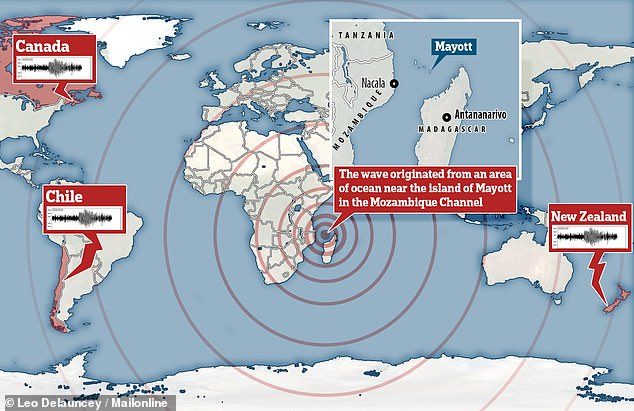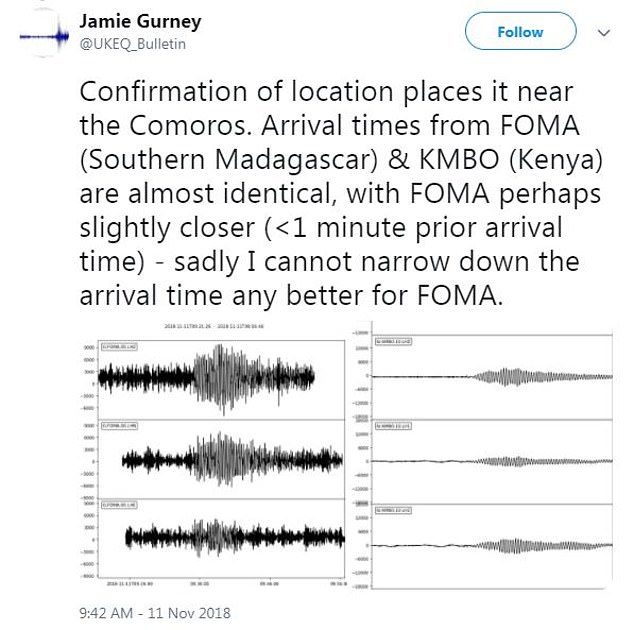
A low-rumbling that could not be felt above ground was detected on November 11 and narrowed down the origin to a region just off the coast of the island of Mayotte.
They were similar to those typically seen after large earthquakes, which are known to travel great distances - but, no such earthquake took place.
Theories as to what caused the cryptic rumble ranged from a slow earthquake to an undetected meteor strike.
But one scientist who has studied the charts told MailOnline that the trembling was 'almost certainly' caused by a low-level underwater volcanic eruption off the northeast of Mayotte.
Anthony Lomax, an independent seismology consultant, said the shakes were 'almost certainly' caused by undersea activity, not very deep under the seafloor, to the northeast of Mayotte.
'There has been ongoing low-level seismic activity there since May,' he told MailOnline.
Comment: There has indeed:Abnormal earthquake swarm continues on French Indian Ocean island of Mayotte, locals suffering from anxiety and stress
'Inflation/deflation and collapse of volcano calderas, and movement of magma under a volcano can produce a wide variety of seismic signals, including long period and repetitive waves like those observed November 11.'
The monotone 'ring' was picked up by seismographs almost 11,000 miles (18,000 km) from Mayotte, and were spotted by chance.
A New Zealand based Earthquake enthusiast who goes by the handle @matarikipax noticed unusual seismology readings from the US Geological Survey.
The agency publishes all of its recordings for free online, allowing anyone across the globe to trawl through its data.
'This is a most odd and unusual seismic signal. Recorded at Kilima Mbogo, Kenya,' @matarikipax wrote on Twitter on November 11.
'The signal can be seen all around the world.'
Their posts sparked the interest of seismologists on Twitter, starting a global discussion as to what caused the covert shakes.
Many others chimed in to the conversation to point out where else the low-frequency waves were detected: Chile, New Zealand, Canada, and Hawaii.
They are unusual because of their monotone, low-frequency 'ring', as well as their global spread.
During a typical earthquake, the build up of tension releases in a flash of mere seconds, releasing a powerful 'ping' of pressure.
The fastest travelling signals, known as primary or P waves, reach seismographs first, and produce a bunched-up reading of repeated tremors.
They are followed by S or secondary waves, which register as longer, side-to-side motions.
Finally, 'slow waves' reach seismographs, which are prolonged rumble - much like the waves triggered at Mayotte.
These signals seemed to propagate without a triggering earthquake - and that wasn't all that piqued the interest of scientists.

Instead, the zigzagging pattern it produced was primarily made up of one type of wave, which took 17 seconds to repeat.
University of Plymouth Geology Graduate and founder of UK Earthquake Bulletin Jamie Gurney said he had 'no idea if a similar global signal of this nature has ever been observed'.
Scientists are working to understand what spurred the mysterious waves on that day.
So far, many suspect they're related to an ongoing seismic swarm in the region that began last May.
Hundreds of small quakes have hit the region during that time, with the largest reaching magnitude 5.8 on May 15.
But even then, there was no corresponding earthquake on November 11.
Researchers with the French Geological Survey (BRGM) say it could be a signal that magma beneath the volcanic island is shifting offshore.
Others say there may have been a 'slow' earthquake that simply went by unnoticed, or an underwater eruption.
The experts say the complex geology of the region further compounds the issue, potentially filtering some of the waves to make the clean signal, NatGeo reports.
Scientists plan to survey the ocean to find out any additional information that could help to explain the mysterious phenomenon.
But at this stage, the experts agree there's just too much we don't know to say what was really to blame.



Comment: This has created a buzz in the scientific community, because seismic signals from earthquakes and volcanic eruption are 'spikier' and don't look 'harmonious' like this. It's gotta be something cosmic. Did Earth just get 'pinged'?! (And no, not by 'aliens' - rather, by something "bigggggg" but as yet unseen...)
By the way, one week later, this happened:
Despite unusually quiet Sun, solar wind recently produced 'musical waves' in Earth's magnetic field